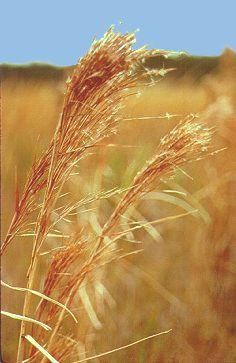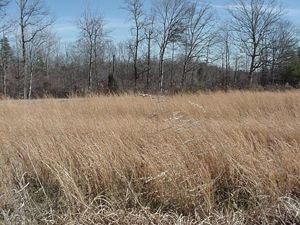|
|
|||
|
THIS WEEK at HILTON POND |
|
IN THE MIDWINTER SUN In 1982, when we bought the property that is now Hilton Pond Center, most of the 11 acres had been in agricultural use for perhaps a century. A few years before our purchase, the previous owners had quit planting crops and grazing cattle, so except for a closely mowed lawn around the old farmhouse, the acreage was in early stages of vegetational succession. By the time we moved in, most of the soil was covered in Broomsedge, a prolific perennial native grass that may attain its densest growth in the Carolina Piedmont. In those first years on the property, one of our favorite winter activities was watching sunsets over the pond and the Broomsedge field that surrounded it. When all else is drab and gray in mid-January, there's nothing quite like that radiant, golden glow of Broomsedge in the late afternoon sun.  Usually an indicator of poor but well-drained soil, Broomsedge--which is a true grass and not actually a sedge--inhabits sunny hillsides and savannas, abandoned fields, roadsides, and open woods across the Southeast. A persistent and opportunistic plant, it occasionally shows up in bogs and even thrives on elevated hummocks in salt marshes along the coast. As many as a half-dozen similar species of grasses occur in the Southeast, mostly on the Coastal Plain, but Broomsedge--Andropogon virginicus--is the most common type in the Carolina Piedmont. In the prairie states, A. gerardii and A. scoparius--Big Bluestem and Little Bluestem--were the more dominant naturally occurring andropogonid grasses, but they have been eliminated from many areas by farming and overgrazing. Unless you live in the middle of a city surrounded by concrete and asphalt, Broomsedge puts in at least a token appearance somewhere near your Piedmont residence. It often invades vacant urban lots or grows on uncut highway medians, but is at its finest on the multitude of fallow farms that dot our area. Depart a Piedmont town on nearly any road, and within a mile or two you'll likely be treated to the pleasing panorama of a Broomsedge field. Frequently the field will be edged or interspersed with a colony of dark, conical Eastern Red Cedar trees (top photo).
During its sojourn, the Broomsedge plant sprouts from its rootstock, forming a dense clump of a dozen or so stalks. Primary propagation occurs after the plant blooms in September, producing seeds with delicate feather-like wings. These wings aren't big enough to carry the wind-borne seed over great distances, but they're just fine for expanding Broomsedge territory a few yards at a time. As the commonest member of its genus in the east, Broomsedge provides valuable cover for some wildlife species but may grow too densely for others. During winter months, Dark-eyed Juncos, Chipping Sparrows, and Field Sparrows hide among the grassy clumps and get a dietary bonus from nutritious Broomsedge seeds. These songbirds often perch high on the plant's tough, erect stalks, plucking and discarding the feathery seed wings and eating the narrow, half-inch-long fruits. White-footed Mice and other small rodents also dine on seeds and leaves of Broomsedge; White-tailed Deer are known to browse on its young foliage, but mature plants are usually too dry and nutrient-poor to provide much forage value. Broomsedge fields survive even when small numbers of domestic cattle graze within them, probably because the cows appear to select greener grasses and succulent weeds rather than Broomsedge. This survival is important, because the dense roots of Broomsedge can help keep topsoil from washing into rivers and streams--even when cattle hooves loosen and disturb it.
We find our words falling short as we try to describe how Broomsedge looks, so perhaps late in the afternoon this week you might simply walk into some old abandoned field in the southeastern U.S. Watching the sun move lower in the sky, you'll likely understand why we delight in Piedmont Broomsedge fields--aglow in the warm, mellow light of the peaceful afternoon sun. We miss our old stand of Broomsedge here at Hilton Pond Center, but natural succession was bound to replace it with our current crop of pine and hardwood. If you enjoy "This Week at Hilton Pond," please help Support Hilton Pond Center for Piedmont Natural History. It's painless, and YOU can make a difference! You may wish to consult our Index of all nature topics covered since February 2000. |

 Broomsedge seeds often germinate in abandoned farm fields the spring after cultivation ceases. That first season the plants may only get six inches high, but their root networks spread rapidly, and by the third year three-foot-tall Broomsedge is well on its way to becoming the dominant plant in early old-field succession. Asters or other plants sometimes dominate abandoned fields if there is sufficient water, but Broomsedge typically asserts itself during rain shortages common to the Piedmont in mid- and late summer. Eventually, shrubs and young trees will take over old fields; by then, Broomsedge has spent six or eight years as "king of the hill."
Broomsedge seeds often germinate in abandoned farm fields the spring after cultivation ceases. That first season the plants may only get six inches high, but their root networks spread rapidly, and by the third year three-foot-tall Broomsedge is well on its way to becoming the dominant plant in early old-field succession. Asters or other plants sometimes dominate abandoned fields if there is sufficient water, but Broomsedge typically asserts itself during rain shortages common to the Piedmont in mid- and late summer. Eventually, shrubs and young trees will take over old fields; by then, Broomsedge has spent six or eight years as "king of the hill." Against the blue of a crystal clear sky, Broomsedge seems to glow, sometimes appearing reddish or pale orange, sometimes having the same color we imagine when we hear the verse about "amber waves of grain." From a vantage point in the middle of any Broomsedge field on winter afternoons, you get a visual treat whichever way you look. Stand with the sun warming your back (above right) and the Broomsedge ahead of you can be a subtle tan color, or be aflame in its unique golden aura. If you face west, the plants' backlit stalks are outlined by millions of tiny glowing halos where seed wings diffuse the light.
Against the blue of a crystal clear sky, Broomsedge seems to glow, sometimes appearing reddish or pale orange, sometimes having the same color we imagine when we hear the verse about "amber waves of grain." From a vantage point in the middle of any Broomsedge field on winter afternoons, you get a visual treat whichever way you look. Stand with the sun warming your back (above right) and the Broomsedge ahead of you can be a subtle tan color, or be aflame in its unique golden aura. If you face west, the plants' backlit stalks are outlined by millions of tiny glowing halos where seed wings diffuse the light.
